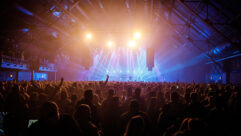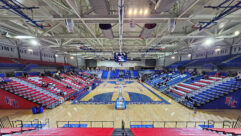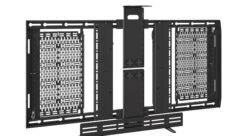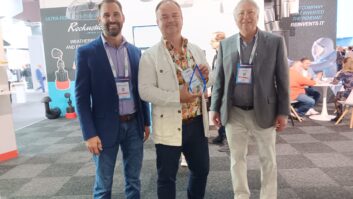

When the historic Hotel Roanoke and Convention Center needed a complete sound system upgrade, they called in IES Communications for the job and project manager Jim Hogan is here to tell us how they pulled off this huge project with Bose speakers and Shure wireless mics. Coming right up on the SVC Podcast.
Jim, it’s great to have you with us on the SVC Podcast from Roanoke, Virginia and IES Communications. We’re going to be talking about a very big sound system renovation at the historic Hotel Roanoke and Convention Center but before we get into that, tell us a little about IES Communications. From your web site, it looks like a lot of different things going on there.
Well, IES commercial is a pretty large nationally publicly-traded company that’s made up of a couple of different groups, one being commercial electric, and our group of course being the communications group. We’ve got offices all across the country. Our communications group is growing daily, so as we speak we’re getting larger. [Timestamp: 1:35]
Well, you’re certainly not afraid to take on the big projects. I think this place is something like 63,000 square feet and it’s on the National Registry of Historic Places which could have presented some difficulties. What part of the Hotel Roanoke and Convention Center was involved in this? You first had to get the old sound system out didn’t you?
That’s correct. About 20 years ago they did a large expansion through the Hotel Roanoke and that’s when it became the Hotel Roanoke and Conference Center. Prior to that, for many years, it has been one of the finer meeting places in our area, but at that time they did a joint venture with the city of Roanoke and Virginia Tech University to build the larger convention center. Our work was all taking place in the convention center; ballrooms, small meeting rooms, and then there was one section which was their lecture hall – the Washington Lecture Hall – which is their show place. It’s a little smaller, it’s about a 100-person meeting space, but a little more high-end area, a little higher-end space, if you will, designed for a little more high-tech type meetings. [Timestamp: 2:45]
What did they have in there as far as a sound system that you had to replace?
The main ballrooms and meeting spaces at the time were very much a state-of-the-art IED system. It was all automatic mixers with – pretty much everything is preset with room controls for each area with multiple mic and line inputs throughout the rooms. But it was all mechanically done, mechanical patch base, separate preamps, EQ’s, amplifier modules. Our job was to replace the entire head end. The mechanical patch phase at the time started making a lot of racket and had the tendency of, especially if they don’t get used every day and switched up every day, but they have a tendency to get noisy and have some failure. A lot of the power amps and stuff, with 20 years of use on these things, they both had become obsolete and they were having many equipment failures – amplifier failures. [Timestamp: 3:49]
Is the lecture hall located away from the ballroom? I saw it was referred to as the remote lecture hall.
Yes. There’s two floors to the convention area and the lecture hall is on the lower level kind of away from a lot of the other spaces or from the larger spaces. And then there are a few smaller convention meeting rooms in the area where the lecture hall is. But it’s a separate stand-alone room. It’s an extremely reverberant space. It’s always been problematic acoustically. Speech intelligibility has always been problematic in there. [Timestamp: 4:23]
And how is its sound system tied into the main system now?
Now we have tied it using fiber over the Dante network. We’ve got a main rack that we’ve got half a dozen strands of fiber running between the two racks and that we used a remote rack that’s in the lecture hall to feed a few of the smaller conference rooms in that area, the ones that are close by. But using the Dante, we were able to go back and forth sending whatever we want wherever we want with pretty much – it’s pretty simple to do. It’s just a matter of pulling it up and programming it in and we can route stuff to and from with ease. [Timestamp: 4:48]
Was there existing network cable or did you have to run all of the twisted pair for this new system and run all the lines yourself?
Well, all the mic-level stuff was in place. We installed all the network communication. We put in the fiber and we put twisted pair to each of the rooms using the CAT-5, CAT-6 rather for feeding control panels in each of the ballroom spaces. But all of the line-level stuff was in place. We went through and pretty much went through every wire in the place, re-terminated and retouched it and repaired any of the issues throughout the space and the copper that was already there, and then we put in all the network cables new. [Timestamp: 5:42]
And so what are they using now for mixing in each area? Is that all the same?
Well, no. Previously they were using digital consoles for larger events and we replaced everything using Surface tablets and Microsoft-based Symetrix program. We did a custom software installation. So all of the user interfaces were custom built by IES using the Symetrix. [Timestamp: 6:07]
Yes, the Symetrix I believe was the SymNet Radius AEC?
Yep. We used the Radius AEC and then we used the break ins and break outs for additional expandability. Of course none of that has any operator controls on it, so everything that we did is all software based. We have a couple of remote tablets that they can walk around with that are on the hotel network that can go from room to room and combine and mix remotely. And then at both of the head ins we have touch panels in operation. At the main head in we used the Symetrix touch panel. For the remote we used some tablets for that purpose. [Timestamp: 6:51]
What additional capabilities does it have other than mobility – which is great to have in a place covering that much area. What other capabilities did they get out of this that they didn’t have before?
I don’t know that they gained a lot of things that they didn’t have, but we were able to keep what they were able to do before by carrying around clunky digital consoles. Now all they’ve got to do is carry a tablet around. So these guys were actually pretty spoiled when we came in because they’d been using digital consoles, and they do a lot of their own production – even a larger-scale production where they’ll bring in fly cabinets and speakers. Previously they were using digital consoles for any and all of that. [Timestamp: 7:30]
Yeah, so they were having to use the big stuff even for small events.
Even for small events. And due to the age of the equipment – I mean let’s face it, it was 20 years old. It was great when the system was first installed, but there was some miles on it. There were issues with preamps and problematic inroads, and they had actually got to the point where most any event they were carrying in a small mixer or digital console to make them work. We’ve eliminated that. Now they’re not carrying any consoles around now. [Timestamp: 7:58]
I know that’s a great thing for them to be able to mix while they move around that big area. I mentioned at the beginning that this is on the National Registry of Historic Places. Did that put any constraints on where you could drill or rig things?
Fortunately for us, most of the work that we did was not at any of the historic areas, but there were several challenging areas to get access to. For instance, in the front outside foyer, we set it up and added just a little walkway there that we set it up so they can have small events in this one walkway. And then there’s some outdoor Bose speakers that were mounted along this walkway and trying to get to it, it was never really designed to have access to these areas. At points it got pretty challenging trying to get cables from A to B, but that was the biggest challenge, being able to get some of the cabling to different locations when we had to. Most of the areas that we had located, and even a couple where we put new speakers, we tried to make it as discrete as possible. [Timestamp: 9:01]
A lot of room to have to get around in. I was wondering why you decided on the Symetrix SymNet Radius AEC. Was there anything special about the features that made it especially good for this project?
Well, obviously the Dante availability was huge. We’ve worked with Symetrix for quite some time. I’ve done several systems, larger systems, that I’ve used their gear on and we’ve just got a great relationship with them. Their support has been great for us and we enjoy using the product. It works. It’s rock solid. I’ve got a SymNet system that’s been up for close to 10 years, obviously it was a CobraNet system, in a stadium we did almost 10 years ago with virtually zero failure. So it’s rock solid, it works and it keeps on ticking. [Timestamp: 9:55]
Well, that’s probably a good idea just to stay with what works.
That’s it. That’s why we stick with it. It works.
Well, Jim it’s been great having you with us for part one and in part two we’ll get into wireless mics and the Bose speakers. Jim Hogan with IES Communications and the big sound upgrade at the Hotel Roanoke and Convention Center.
Thank you for your time.
To bring the sound system up to present day technology at the Hotel Roanoke and Convention Center, IES Communications installed Dante-enabled SymNet DSP, Bose speakers and Shure wireless mics. Project manager Jim Hogan is back to finish up his account on how they got it all in and up and running. Coming up right now on the SVC Podcast.
Jim, thank you for being back with us for part two on the SVC Podcast from IES Communications in Roanoke, Virginia; the big sound system upgrade at the Hotel Roanoke and Convention Center, a sixty-three thousand square foot place with a lot of ground to cover. In getting the old system out first, how much work was involved in that part of it?
Well, there was a considerable amount of old gear that we had to remove. The head end rack was four bays full of gear that we really condensed down to about two bays, but we had to get it all out and remove it from the site. Fortunately, it was pretty easy access getting things in and out. [Timestamp: 1:29]
And what was the particular attraction of the Bose Modular Line Array speakers for this one? Had you used those before or was it just a matter of the specs being right?
Actually I was the one who chose to use the modular array system, and the reason being is that we had done several projects where there were highly reverberant spaces that these modular array boxes are very well behaved and they do a really good job of controlling and doing vocal reinforcement or speech intelligibility for highly reverberant spaces. I’ve been using these for several years. They’re reasonably priced and they do a great job. They’re well behaved. I was actually very amazed the first time I heard them, the first time the Bose rep brought them around and let me listen to them. Bose has always been famous for their small loudspeakers and the guy brought these little skinny, long – they’re about 40 inches long per box – and when I walked around to the edge of it and the sound just disappeared, I said this is pretty awesome. The physics behind it – the way they work – when you stack them up essentially your pattern is as tall as your speaker stack is, so they work well and they’re affordable. [Timestamp: 2:51]
And they’re almost invisible in most environments. Their shape and size really helps those to blend right into the background.
They almost disappear. They’re, as you say, very small in size and even when you put a tall array together. We did two different systems in here using the modular arrays, one being the lecture hall. We used a triple stack in there and that enabled us to get good speech intelligibility to the back of the room without a lot of problem, and then we also put a small outside system. The MA12EX’s are weather resistant, and we had a patio area that they use for a lot of weddings and private parties. We took a double stack, mounted them onto posts of a cover and you can’t see them when you get on the other side of the area. It’s their patio and deck area. We used the dark ones there and it’s some dark wood posts and you can’t hardly see them. [Timestamp: 3:55]
And you also put in a Shure wireless mic system. Were there any frequency coordination issues with that? Did you use the coordination software like the Shure Wireless Workbench?
Well, we did use the Wireless Workbench. We also used a couple of the Dante features in a few of them. They actually cut back tremendously from what they had originally planned to use on the wireless system. Originally there was plans for about 20 more systems than we ended up putting in. We put in about 12 of them. There were originally, I think, going to be 20 more but due to some financial constraints – they already had a few. I think they already had about half a dozen of the digital systems in place, and the people here, they knew what they wanted. They were happy. They knew that this worked and obviously for us it’s great. In a couple of remote locations that we needed to reach using the Dante made it a lot easier to use those as well. [Timestamp: 4:55]
Yeah, it sounds like the wireless mic system they had in there was probably not quite as old as the original equipment?
Actually I believe the oldest systems that they had were some ULX systems that we replaced. We pulled out, I think, about four of those, but none of that equipment was original equipment. That was stuff that they’d added over the years and I think they had put in a couple of systems in the last couple of years and they’d put in a couple of ULX-D’s. So they were already aware of what was possible with that. [Timestamp: 5:25]
What did you have to do on the power? Was there any modification that had to be made to add capacity for powering all the new gear?
Actually the power is now more efficient than it was. It’s not drawing as much current as it was before we started. So it was all in place and it made it real easy for them, made it real easy for us, too, so it was all right there. They didn’t have to do any upgrades, which was great. [Timestamp: 5:46]
Well, I know that’s a busy place and you had a lot to do to get the whole thing ready in between scheduled events. How big a crew did you have for this and how did the testing go when it was all hooked up?
Well the install, actually because of having to coordinate and work around events because the place gets so busy, we pretty much worked with a six-man crew throughout the project and we bumped it up a couple guys. We spent one entire weekend doing a switch over when we actually killed the old system and switched it over and hooked up the new system. We only had five days to make that switch over, so we bumped it up a little bit there when we had to do the head-in part so we could make sure we got it up and going without any issues and being able to meet their crazy schedule around here. [Timestamp: 6:37]
And they’ve got pretty much automated mixing capability now but what are the various sources that they can put up besides the mics?
It’s somewhat limited. I guess throughout the convention area they don’t do a lot of additional. They do a little bit of video, not a ton of video, which I know that’s something that they’re working towards in the near future, but primarily mic and line level now. In the lecture hall we did do a full 7.1 surround sound system there and we put in a Blu-ray system with a Blu-ray player with a digital input and a surround sound processor. We used an Extron surround sound processor and interfaced it with the Bose amps and it turned out nice. So we’ve got awesome surround sound in the lecture hall. [Timestamp: 7:26]
Of course, they can have a lot of different things going on there at the same time. Do they ever bring in a truck and televise anything out of there?
Well, they have full capability. There is separate TV infrastructure that’s been here really as long as the building has. It’s aged. They don’t use it a lot, but they have the capabilities. That cable is already existing and we left it independent. We didn’t touch that. We used it a little bit to cheat – sometimes when they want to get some special cabling across the room or something, but it’s a broadcast cable infrastructure in place. [Timestamp: 8:01]
Well, that’s a future project for you then.
That’s it. We’re hoping that one day we’ll be able to replace that as well, especially with the video aspect of things. And of course things are changing so much these days, we can probably use some of the existing network cabling that we put in to help with that. [Timestamp: 8:20]
Just future proofing it is enough of a big job I’m sure.
It’s a challenge. It really is.
So what’s coming up next?
We do a lot of work in the K-12 business. We’re currently working on about three different high school projects. We do some stuff with the local universities around here. We’ve got a couple of fairly good-sized university projects that are coming up in the near future. Probably the biggest one that I’m working on is when I’m partnering with one of our other offices. And we’re doing a large hospital project out in El Paso, Texas. That’s the biggest one that we’re currently engaging in. [Timestamp: 8:59]
It’s been fun hearing about this one and thanks for telling us about it. Jim Hogan with IES Communications in Roanoke, Virginia and the Hotel Roanoke and Convention Center total sound system renovation. I’m sure they’ll be calling you guys back when they upgrade the video there.
Sounds good. Thank you so much for your tim










